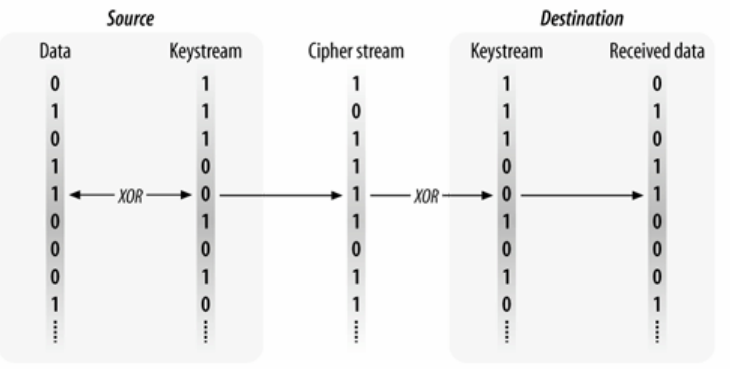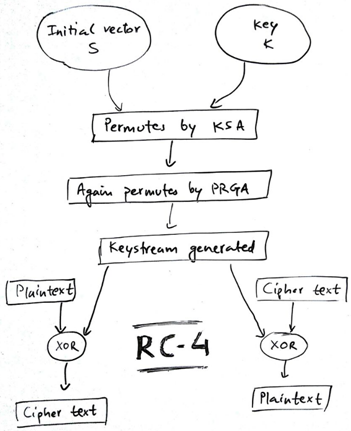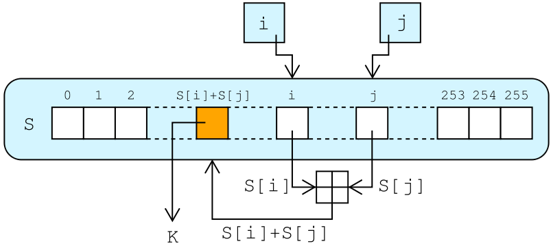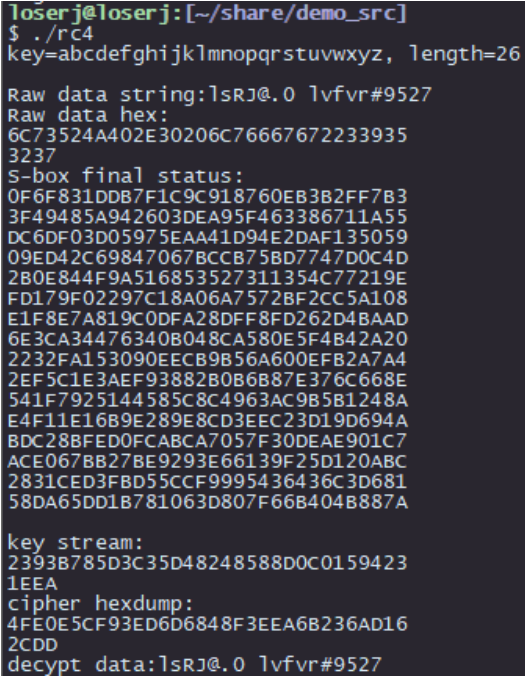什么是RC4 ?
RC4加密算法是大名鼎鼎的RSA三人组中的头号人物Ron Rivest在1987年设计的密钥长度可变的流加密算法簇,之所以称其为簇,是由于其核心部分的S-box长度可为任意,但一般为256字节。
在密码学中,RC4(来自Rivest Cipher 4的缩写)是一种流加密算法,密钥长度可变。它加解密使用相同的密钥,因此也属于对称加密算法。所谓对称加密,就是加密和解密的过程是一样的。RC4是有线等效加密(WEP)中采用的加密算法,也曾经是TLS可采用的算法之一。
RC4已经成为一些常用的协议和标准的一部分,如1997年的WEP和2003/2004年无线卡的WPA; 和1995年的SSL,以及后来1999年的TLS。让它如此广泛分布和使用的主要因素是它不可思议的简单和速度,不管是软件还是硬件,实现起来都十分容易。
基本原理
对明文使用同一个密钥异或两次最后得到的是原文
- 加密:原文和Keystream进行异或得到密文
- 解密:密文和Keystream进行异或得到原文

图片来源:《802.11无线网络权威指南》 第 5 章 图5-1 串流密码锁的一般运作程序
流程图解

生成秘钥流(KeyStream)
从上图可以看出来,RC4加密原理很简单,只需要一个KeyStream与明文进行异或即可,密钥流的长度和明文的长度是对应的。RC4算法的的主要代码还是在于如何生成秘钥流。
密钥流的生成由两部分组成:
- KSA(the Key-Scheduling Algorithm)
- PRGA(the Pseudo-Random Generation Algorithm)
利用Key生成S盒——The key-scheduling algorithm (KSA)
/* 得到S-box */ int i = 0; for (i = 0; i < 256; i++) { S[i] = i; T[i] = puc_key[i % key_length]; } for (i = 0; i < 256; i++) { j = (j + S[i] + T[i]) % 256; swap_uchar(&S[i], &S[j]); //交换S[i]和S[j] }
利用S盒生成密钥流——The pseudo-random generation algorithm(PRGA)

/* 生成密钥流 Keystream */ int i = 0; int j = 0; int t = 0; unsigned long k = 0; for (k = 0; k < ul_data_length; k++) { i = (i + 1) % 256; j = (j + puc_sbox[i]) % 256; swap_uchar(&puc_sbox[i], &puc_sbox[j]); t = (puc_sbox[i] + puc_sbox[j]) % 256; puc_key_stream[k] = puc_sbox[t]; }
代码实现
#include<stdio.h> #include<string.h> #define SBOX_LEN 256 #define rc4_encrypt rc4_crypt #define rc4_decrypt rc4_crypt static inline void swap_uchar(unsigned char *puc_x, unsigned char *puc_y) { *puc_x = *puc_x ^ *puc_y; *puc_y = *puc_x ^ *puc_y; *puc_x = *puc_x ^ *puc_y; } void hexdump(unsigned char *puc_data, int length) { int i = 0; for (i = 0; i < length; i++) { printf("%02X", puc_data[i]); if (i && (i + 1) % 16 == 0) { putchar(' '); } } printf(" "); } /** * 利用Key生成S盒 * the Key-Scheduling Algorithm */ static void rc4_ksa(unsigned char *puc_sbox, unsigned char *puc_key, int key_length) { int i = 0; int j = 0; char tmp[SBOX_LEN] = {0}; for (i = 0; i < SBOX_LEN; i++) { puc_sbox[i] = i; tmp[i] = puc_key[i % key_length]; } for (i = 0; i < SBOX_LEN; i++) { j = (j + puc_sbox[i] + tmp[i]) % SBOX_LEN; swap_uchar(&puc_sbox[i], &puc_sbox[j]); //交换puc_sbox[i]和puc_sbox[j] } } /** * 利用S盒生成密钥流 * The pseudo-random generation algorithm(PRGA) */ static void rc4_prga(unsigned char *puc_sbox, unsigned char *puc_key_stream, unsigned long ul_data_length) { int i = 0; int j = 0; int t = 0; unsigned long k = 0; for (k = 0; k < ul_data_length; k++) { i = (i + 1) % SBOX_LEN; j = (j + puc_sbox[i]) % SBOX_LEN; swap_uchar(&puc_sbox[i], &puc_sbox[j]); t = (puc_sbox[i] + puc_sbox[j]) % SBOX_LEN; /* 为了更清晰理解rc4算法流程,此处保存keystream,不直接进行XOR运算 */ puc_key_stream[k] = puc_sbox[t]; } } /*加解密*/ void rc4_crypt(unsigned char *puc_data, unsigned char *puc_key_stream, unsigned long ul_data_length) { unsigned long i = 0; /* 把PRGA算法放在加解密函数中可以不需要保存keystream */ for (i = 0; i < ul_data_length; i++) { puc_data[i] ^= puc_key_stream[i]; } } int main(int argc, char *argv[]) { unsigned char sbox[SBOX_LEN] = {0}; char key[SBOX_LEN] = {"abcdefghijklmnopqrstuvwxyz"}; //秘钥内容随便定义 char data[512] = "lsRJ@.0 lvfvr#9527"; unsigned char puc_keystream[512] = {0}; unsigned long ul_data_length = strlen(data); printf("key=%s, length=%d ", key, strlen(key)); printf("Raw data string:%s ", data); printf("Raw data hex: "); hexdump(data, ul_data_length); /* 生成S-box */ rc4_ksa(sbox, (unsigned char *)key, strlen(key)); /* 生成keystream并保存,S-box也会被更改 */ rc4_prga(sbox, puc_keystream, ul_data_length); printf("S-box final status: "); hexdump(sbox, sizeof(sbox)); printf("key stream: "); hexdump(puc_keystream, ul_data_length); /* 加密 */ rc4_encrypt((unsigned char*)data, puc_keystream, ul_data_length); printf("cipher hexdump: "); hexdump(data, ul_data_length); /* 解密 */ rc4_decrypt((unsigned char*)data, puc_keystream, ul_data_length); printf("decypt data:%s ", data); return 0; }
运行示例:

参考
《802.11无线网络权威指南》 第5章